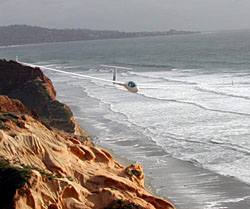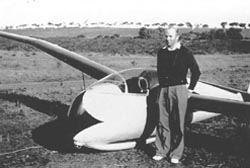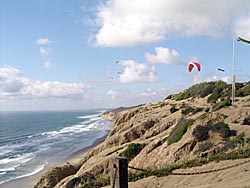
Torrey Pines Gliderport played an interesting role in the aviation industry of Southern California. Beginning in 1930, this site was used for motorless flight. Gliders were car-towed off the beach parallel to a 350-cliff so they could fly in the lift created by the prevailing westerly wind at Torrey Pines. The nearly flat land of the mesa east of the cliff was used for launching and landing, providing a natural emergency runway. Many aviation pioneers flew at Torrey Pines. On February 24, 1930, Charles A. Lindbergh flew in the lift at Torrey Pines in a flight along the coast from Mt. Soledad to Del Mar, thereby establishing a claimed distance record. In 1936, Woodly Brown, who previously flew off the beach, was the first to launch and land on top of the cliff at Torrey Pines. In the late 1930s, Hawley Bowlus, construction supervisor of the Spirit of St. Louis and owner of his own sailplane manufacturing company in San Diego, began flying at Torrey Pines. Bud Perl and Bill Beuby flew at Torrey Pines; the former's Class A license was signed by Orville Wright. The first three-day glider meet at Torrey Pines was held on December 31, 1939.

Torrey Pines was also the location for the development of several new technologies. The Dead-man pulley take-off system (1938) launched sailplanes from cars, instead of the earlier method of several men pulling them off the slope. The Robinson variometer (1939) was a very sensitive instrument used to determine rate of climb or sink in a sailplane. John Robinson designed both of these systems, as well as several highly maneuverable sailplanes named Robin #1 through Robin #4 (1936-1939). Oversized control surfaces with more overall movement were used to give the pilots an advantage while circling in tight thermals, doing aerobatics or having more control on landings. John Robinson's Zanonia sailplane, built and designed by Harland Ross, was the first airplane in the nation to use spoilers (air brakes) on the wings (1939). The spoilers helped reduce lift and slow the aircraft down for landings. An aircraft parachute recovery system invented by Bob Fronius was flight tested here in 1947 to save a "disabled" sailplane. The gliderport is unique in that it was the only legal site where unlicensed aircraft could fly in a civil airway, a license granted exclusively for the Torrey Pines Gliderport in 1938.

Flight operations at Torrey Pines were interrupted in 1941 when the gliderport property became the Army's Camp Callan. Military operations were conducted here until the end of World War II. The first annual Pacific Coast Mid-Winter Soaring Championship was held at Torrey Pines in 1947. John Robinson became the first three-time National Soaring Champion as well as the first American to fly over 300 miles cross-country, the first in the world to fly over 30,000 feet in a sailplane and the first in the world to earn a Diamond "C" badge (the most respected award in soaring). Richard Johnson, who held the title of National Champion in soaring seven times, participated in the Pacific Coast Mid-Winter Championships in the late 1950s and early 1960s. In the late 1960s, radio-controlled model airplanes began operations at this location, and in the 1970s, hang gliders joined the flight operations. The Torrey Pines Soaring Council was established by the Parks Recreation Department, City of San Diego, in 1978 to provide advice and council regarding flight safety and other matters. Torrey Pines Gliderport remains in its natural condition, except for the addition of a runway, the foundation of a small army barrack, and areas graded for current sailplane operations.
Visit the National Park Service Travel American Aviation to learn more about Aviation related Historic Sites.
Last updated: September 3, 2017
